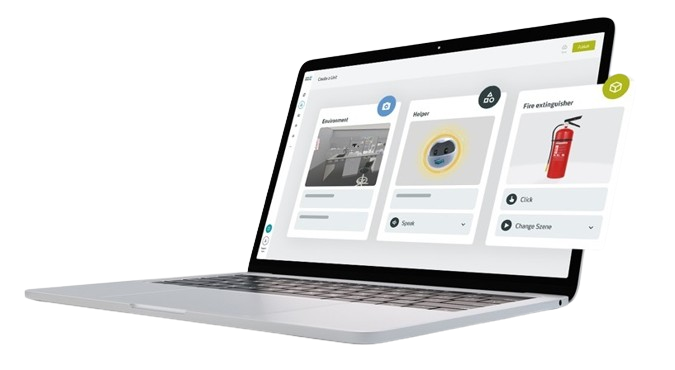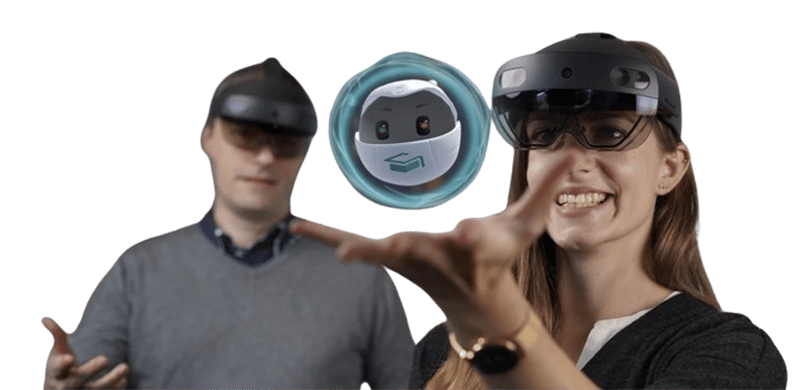Making Digital Employee Onboarding From Abroad Work – BARMER Hub
How the BARMER Hub uses Virtual Reality for the onboarding of international employees from abroad for smooth integration.
Discover how VR is redefining onboarding. Efficient, sustainable training, higher employee retention, and cost savings with digital onboarding.
01. What is a Digital Onboarding Process?
02. Why is Digital Recruiting and Onboarding so Important?
03. What Are the Typical Challenges in the Onboarding Process?
04. Digital Recruiting and Onboarding Benefits
05. Possible Digital Recruiting and Onboarding Drawbacks
06. How Long Does Successful Onboarding Take?
07. How do you Design Digital Onboarding?
08. How VR and AR add Value to the Recruiting Process
09. How Much Does Great Onboarding Software Cost?
10. How to Facilitate Virtual Onboarding with 3spin Learning
Although the onboarding process has seen innovations, remote working, and working from home, the approach to knowledge transfer and on-the-job training has remained largely unchanged.
Training, onboarding, and professional development activities in many companies are lecture-based, monotonous, and largely rely on attendance and memorization. Additionally, lack of time and constraints due to individual learning habits negatively impact employee and employer motivation.
This approach to specialized onboarding can be costly, slow, and relatively ineffective, and carries the risk that employees will not properly learn the skills or instructions required for their jobs and, accordingly, could significantly harm the company in the long run
Companies need a new form of onboarding and training that engages and excites employees and can be used over the long term. Here, the use of Virtual Reality represents the ideal way to improve employee onboarding, training, retraining, and more.
In HR and talent management, digital onboarding refers to a form of structured orientation that is carried out virtually, i.e. without a face-to-face meeting. Many organizations use digital onboarding to carry out so-called "functional inductions". These briefings usually take place before practical training begins and allow new employees to familiarize themselves with their roles and the company's clear expectations. This significantly facilitates the familiarisation of new employees.
The term digital onboarding is also used in all areas in which companies need to integrate a person into their structures – for example as a customer in eCommerce. The onboarding process should ensure quick and easy access to all of an organization's services and products.
Even before the Covid pandemic, only 12% of employees surveyed agreed that their company did a good job of onboarding, according to a Gallup poll. It's no surprise then that nearly one-third of new hires begin their search within the first six months of starting their job (Harver), and estimates put the average cost of hiring at about 30% of the annual salary of those being hired (Forbes).
Likewise, 58% of millennials prefer high-tech services like VR and AR to free snacks and ping pong tables. (Forbes)
This data shows that onboarding is a key part of the employee lifecycle in organizations. A proper formal and digital onboarding process prepares employees for success accordingly.
Studies show that new employees are two times more likely to retain content in long-term memory after a virtual learning process than after viewing traditional video- or text-based learning materials, as people are immersed in digital learning situations as though they had been there live, thanks to the computer-generated environment of VR and AR.
VR Training not only allows companies to train their employees faster, but also participants remember what they have learned better. This is due to the so-called image superiority effect, which states that content is more likely to be recognized and recalled the more vividly it is presented. This means that we can remember a picture of a red apple more easily than the word "red apple".
Want to successfully train new employees and retain them in your company in the long run? We support companies in redefining their corporate image.
Shortage of skilled workers or too few potential applicants and the associated high costs of recruiting and hiring.
No standardized processes for pre- and onboarding as well as for professional training and social integration.
High travelling and training costs for onboarding measures.
Employee training spread across multiple locations leads to high costs and ineffective onboarding.
Lack of employee engagement in traditional training.
Training outcomes cannot be measured and stored in the LMS.
Using Virtual Reality offers a huge optimization potential for your HR processes and supports all challenges, especially with the activation of long-term memory.
VR and AR training not only saves companies huge costs through less travel but also reduces the environmental footprint and workload of employees through location-independent working, thus ensuring an increased work-life balance as employees can train regardless of location and on their schedule.

Companies can hire their employees regardless of location, allowing qualified candidates to be found and hired globally.
VR onboardings provide realistic training in a virtual world that mimics the real world, so new employees gain the skills they need faster.
Thanks to VR, new employees get a clear picture of the company culture before their first day on the job.
Companies showcase their facilities with virtual tours and job applicants get to know their future work environment.
Familiarization processes only need to be created once and can then be accessed uniformly, anytime and anywhere.
One of the biggest challenges for HR management is implementing an engaging remote onboarding strategy, especially with many new hires. At 3spin Learning, we help companies with their employee onboarding processes and open up virtually unlimited possibilities in the onboarding of new employees through realistic learning environments.
There is no adequate substitute for daily direct contact with team members, especially in the first few weeks of work. For this reason, we have developed the Learn together module on our learning platform so that new employees can establish and maintain close contact with their colleagues within the VR world.
This is how digital transformation and the introduction of new technology in a remote work environment can provide more accessibility.
Off-site onboarding can come at the cost of employee retention. The office environment can sometimes be a deciding factor for job seekers when deciding which company to work for. HR departments here need to be able to maintain a quality company culture.
With the ease of our many awesome VR features, 3spin Learning gives you the ability to bring new or existing VR content to life.

It takes around six months from signing the contract to successful professional integration and full performance – the length of the probationary period in a company. After one year of working for the same organization, employees are expected to have mastered the skills associated with their tasks.
The next step is therefore to turn these employees into future managers of the company. They follow in the footsteps of their superiors, who in turn will replace their superiors, and so on.
Good onboarding means that management encourages and challenges its employees and is interested in the professional development of specialists. Nobody wants to remain in a position that has low requirements and offers an even lower salary. Satisfied employees stay with the company longer!
We recommend using Virtual and Augmented Reality with 3spin Learning during the onboarding process. The software is easy to use and user-friendly - without any programming knowledge and regardless of how tech-savvy the user is. In addition, any training created by your management can be reused at any time.
Especially when it comes to remote onboarding, companies should provide all the necessary tools and software. Even before the first day of work, digital signature software solutions can ensure that communication and collaboration run smoothly right from the start. For example, 360-degree Training and virtual tours help new hires get to know each other in person and make them feel welcome at their new workplace even before their first day of work.
Structured onboarding's main goal is to meet the expectations of both parties. Here, the company needs to communicate what it expects from its new employees through transparent communication. This is where VR and AR Training can help impart knowledge and provide the appropriate digital support - especially in the home office.
After six months, new employees should have fully integrated into your organization and developed the necessary skills to perform their tasks and fit in well with the company. At this stage, feedback sessions as well as company-wide training courses are ideal. For this purpose, classic eLearning platforms are usually not sufficient to generate interactively appealing training material.
Especially in a competitive job market, employers are trying everything they can to give potential workers a good feel for what it would be like to work for the company. Virtual and augmented reality technology can help job applicants experience what it would be like to work in certain jobs or for certain companies while still in the application process.
For example, recruiters can use VR goggles to test an applicant's skills in a virtual environment. The use of VR and AR in HR also allows for realistic online simulations where applicants can explore their future jobs and interact with employees.
If you're like most HR departments, you probably lack the financial flexibility to add a large set of tools to your HR technology suite. Each new program requires a new line item in your budget, and getting approval for a new system from your leadership team isn't necessarily easy.
Today, with software solutions such as 3spin Learning, virtual Training can be deployed at very low annual platform fees starting at $5,000 per year - depending on standard or customized options.
Our software solution even offers learning content creation without the need for programming skills. With us, anyone can create and execute hands-on learning content. Our team of experts will be happy to advise you.
With so much opportunity for companies to enter the VR market early, it's a great time to develop an innovative VR software solution.
With 3spin Learning, you get a powerful onboarding tool with a user-friendly and intuitive interface that automates the social integration of your new employees. With our software solution, you can create compelling VR and AR Training courses and replace manual HR processes with SaaS systems.
Our technology ensures lower costs and a shorter development time, as no programming knowledge is required. We would be happy to advise you in a detailed discussion.

How the BARMER Hub uses Virtual Reality for the onboarding of international employees from abroad for smooth integration.
Learn how Virtual Reality takes leadership training to a new level and strengthens soft skills in an interview with digital learning agency vr-train.
AI and VR are driving innovation in drug research through to commercialisation and ensuring better treatment outcomes.
Stay up to date on new insights in VR / AR learning with AI and build or improve your knowledge within the technology.